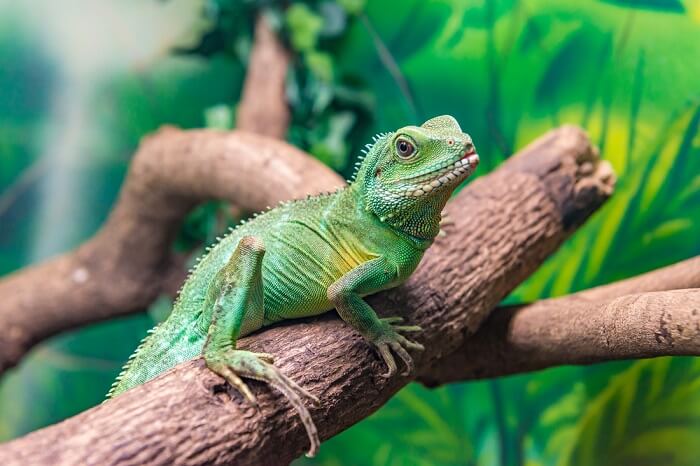What Types Of Pet Snakes Are There?
This page contains affiliate links. We may earn money or products from the companies mentioned in this post through our independently chosen links, which earn us a commission. Learn More
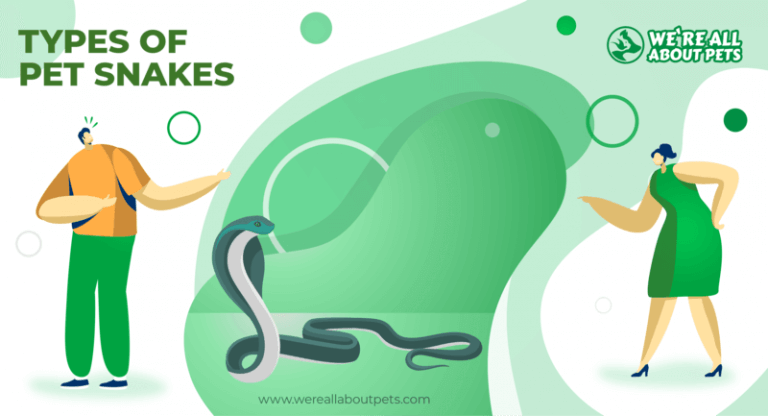
When you walk into a pet store, most of the animals you see are furry little critters. If you head into the reptile section, however, you’ll find some of the most unique and interesting pets on the planet.
Snakes are legless, carnivorous, coldblooded reptiles and they make extremely interesting pets. Proper care is unlike the care for any other pet, and each species is completely unique. Though your experience will vary greatly depending which type of snake you choose, one thing is for sure: you’ll never be bored as a snake owner. These pets keep you on your toes, even though they don’t have any themselves.
Whether you’re interested in keeping a unique type of pet or thinking about breeding snakes at home, there are many options to consider. Read on to learn about the most popular types of pet snakes.
10 Types of Pet Snakes
There are over 2,800 different species and subspecies of snake in the world that have been discovered and more are being discovered each year. While there are thousands of species out there, not all of them are commonly kept as pets.
The most common pet snakes are in the families Pythonidae, Colubridae, and Boidae. We’ve provided a summary of the top 10 pet snake species below.
Here’s a quick overview of some of the most popular types of pet snake:
1. Ball Python (Python regius)

- Origin: West and Central Africa
- Price: $50 to $200
- Size: Up to 72 inches
- Color: Dark brown, black
Often regarded as one of the best pet snakes for beginners, the ball python is the smallest of the African pythons, growing up to 72 inches long. Ball pythons are generally docile and even-tempered and they don’t have complex requirements in terms of heating and lighting.
Reticulated pythons are similar to ball pythons in appearance. It is the world’s longest snake, however, growing up to 21 feet long which makes it challenging to keep as a pet.
2. Rosy Boa (Charina trivirgata)
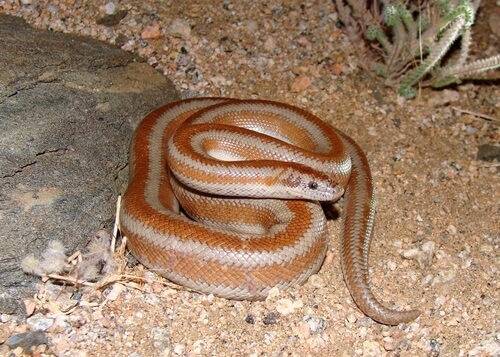
- Origin: American Southwest
- Price: $75 to $125
- Size: Up to 34 inches
- Color: Brown, reddish brown
The rosy boa is native to the American Southwest and can be found in parts of Mexico as well. It is one of two species of boa native to the United States and it is generally fairly small, growing up to 34 inches.
These snakes are docile by nature and generally don’t bite in defense. They typically curl up into a ball and may release a foul-smelling musk. Rosy boas are not venomous snakes and the most common instance for human bites are during feeding.
3. Corn Snake (Pantherophis guttatus)
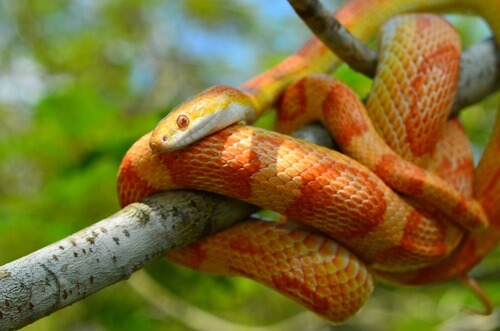
- Origin: North America
- Price: $30 to $50
- Size: 6 feet
- Color: Red, orange, yellow
A species of rat snake, corn snakes are very popular beginner snakes because they are fairly small in size and come in a wide variety of color morphs. Keep in mind that these snakes are great escape articles, however, so you’ll need a secure enclosure. Corn snakes are generally not known to be biters.
4. Green Tree Python (Morelia viridis)
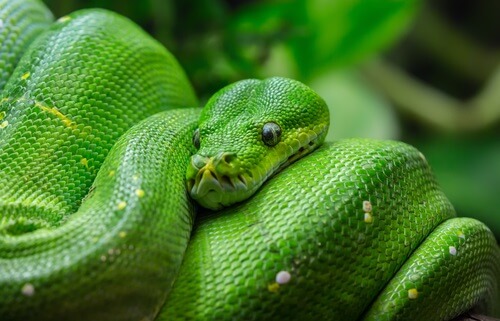
- Origin: New Guinea, Australia
- Price: $100 to $300
- Size: Up to 7 feet
- Color: Green
An arboreal species of python, the green tree python may not be the best option for new snake owners simply because of their habitat requirements. These snakes are vibrant green in color and grow up to 7 feet long, which his why they are often confused with the emerald tree boa. This green snake is a popular pet, but wild populations are being threatened by smuggling.
5. Gopher Snake (genus Pituophis)
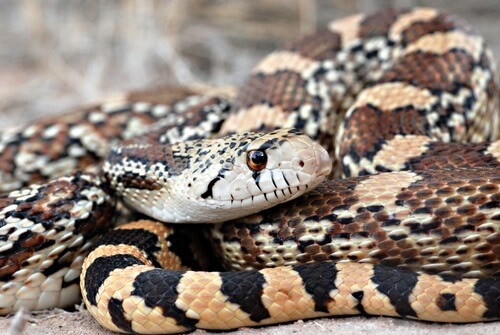
- Origin: North America
- Price: $30 to $100
- Size: Various
- Color: Various
Also known as pine snakes or bullsnakes, gopher snakes are endemic to North America. Though they are nonvenomous, gopher snakes are known for their ability to mimic rattlesnakes by vibrating their tails and producing a hoarse hissing noise. Gopher snakes have a somewhat pointed shape to their head and it is relatively small in proportion to the body.
6. Red-Tail Boa (Boa constrictor)
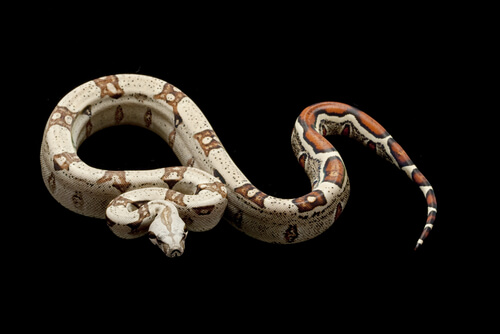
- Origin: South America
- Price: $75 to $200
- Size: Up to 13 feet
- Color: Brown, gray, cream
The red-tail boa is a type of boa constrictor commonly sold as a pet and it grows up to 13 feet long. Though generally fairly docile, red-tail boas don’t make great pets because of their size and because of their long lifespan. They also need to eat fairly large rats or rabbits.
Another popular pet boa similar to the is species is the Kenyan sand boa. Sand boas are a burrowing species and they can be good for new snake owners because they are usually very docile.
7. Burmese Python (Python bivittatus)

- Origin: Southeast Asia
- Price: $300+
- Size: Up to 12 feet
- Color: Brown, yellow
Often the kind of snake you’d see in a magic show, Burmese pythons are very large, growing up to 12 feet in length, but can still be kept as pets. This species of snake is generally very docile, but its size can be intimidating, and it is much more active than smaller pythons.
Burmese pythons are not only very long when fully grown, but they can be quite heavy too. Their size also means a higher food requirement. Pre-killed prey like rats, rabbits, and even poultry are generally required for these carnivorous snakes. These things affect whether they make good pets.
8. California King Snake (genus Lempropeltis)
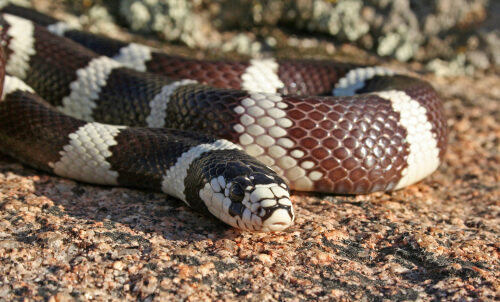
- Origin: Indo-Pacific
- Price: $50 to $150
- Size: Up to 6 feet
- Color: Red, black, cream
Closely related to the milk snake, king snakes grow about 6 feet in length. The name of this species is a reference to the fact that they will eat other snakes, so they should generally be kept alone. These snakes have alternating bands of red, black, and cream color.
The king snake is native to North and South America and one of the species most commonly bred in captivity. Because wild caught snakes are not recommended as pets, the king snake is a good choice if you’re looking for a species that is almost exclusively captive-bred.
9. Milk Snake (Lampropeltis Triangulum)
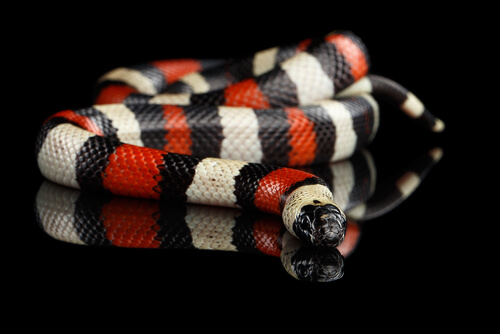
- Origin: North, Central & South America
- Price: $100 to $150
- Size: Over 24 inches
- Color: Red, black, cream
The milk snake is technically a species of king snake, and it is very similar in color. When it comes to the actual pattern, however, it more closely resembles the highly venomous coral snake. Milk snakes are generous docile and easy to keep, making them good beginner snakes.
Milk snakes rarely strike, and they are generally very easy to handle once they get used to you. The only risk is that your snake might confuse your finger for prey, so avoid feeding by hand. The good news is that bites from a milk snake are unlikely to hurt.
10. Black Rat Snake (Pantherophis obsoletus)
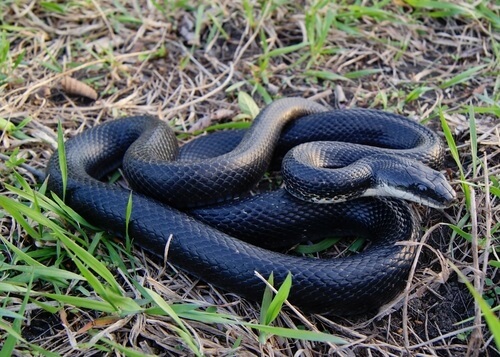
- Origin: North America
- Price: $50 to $100
- Size: Up to 6 feet
- Color: Black
Easily one of the most popular pet snake species, the black rat snake is native to North America. These snakes are not venomous snakes, but they are often mistaken for rattlesnakes in the wild because they often tense up their bodies before striking prey and will sometimes rattle their tails in the brush.
Black rat snakes make great pet snakes because they are generally pretty docile and can be tamed with regular handling. They are escape artists, however, so you’ll need an escape-proof enclosure with a solid latch. Generally speaking, rat snakes are a hardy species that don’t require a lot of maintenance.
The Benefits of Owning a Pet Snake
When you dream of becoming a pet owner, how do you picture it? For many people, the image that comes to mind is one of lounging on the couch with a fluffy dog by your side or a purring cat by your feet. While these may be the typical images of pet ownership, they’re not the only option.
If you like to think outside the box and do something different, you may be interested in a pet reptile. Snakes make great pets if you’re willing to do the work.
Here are some of the benefits of snakes as pets:
- Generally speaking, snakes are fairly easy to take care of, especially in terms of diet. Snakes are carnivores and many species don’t even need to be fed on a daily basis.
- Pet snake require minimal exercise and human interaction (depending on the species). They are fairly self-sufficient and will be happy as long as they have a suitable environment and diet.
- Snakes actually enjoy staying in their enclosure most of the time, as long as it meets their needs. While many pets require time outside the cage to be healthy and happy, the opposite is true for many pet snakes – they often prefer to be in their enclosure.
- A pet snake requires little to no grooming – the most you’ll have to do is adjust the humidity in the tank if your snake is having a challenging shed or adjust his diet to help the process along.
- If you start handling your snake early, most pet snakes actually come to enjoy it. Handling your snake often helps keep it tame and some species actually enjoy interacting with their owners.
- Pet snakes make a surprisingly good option for families. They don’t require a lot of daily care but the whole family can be involved in checking the parameters in the enclosure. Snakes also provide unique opportunities to teach children.
While snakes can make wonderful pets, there are definitely some challenges to consider. The cost to keep a pet snake varies depending on the type you get, so think carefully when making your choice.
Read on to learn some other things to consider before getting a snake.
What to Know Before Getting a Pet Snake
If you’re looking for a unique pet that will keep you entertained and challenged, reptiles are a great option to consider. While some reptiles are difficult to keep simply because of their specific care requirements, many types of snakes are relatively low maintenance as pets.
Before you get a pet snake, however, it’s important to do your research. The amount of work it takes to care for your pet snake depends on the type of snake you get. Consider which type of snake you want and be sure to do some in-depth research to make sure you understand what you’re getting into.
Here are some other important things to consider for pet snakes:
- Snakes can live a very long time in captivity, so be prepared to care for your snake for 20 years or more – ball pythons have even been known to live as long as 40 years.
- While snakes are generally easy to care for, it all starts with setting up their habitat properly. Each species has unique requirements for temperature, humidity, and tank setup, so be sure to do your research before deciding what type of snake to get.
- Pet snakes come in all different sizes, so think carefully about how much space you have. Popular species like ball pythons and corn snakes only grow 4 to 5 feet long while others get much larger. The size of your terrarium or vivarium will be determined by the snake’s size.
- Your new pet snake will spend the majority of its time in its enclosure, so do the research to set it up properly and invest in quality equipment to maintain the proper tank temperature and humidity level. Set it up according to your type of snake’s specific needs.
- Most pet snake types require a higher temperature than you keep in your home, so choose a terrarium that retains heat and equip it properly – you may need to create a hot side and a cool side of the tank as well as basking areas so your snake can regulate its body temperature.
- Some states require pet owners to obtain a license before keeping a snake, so be sure to check with your local regulations to make sure you understand the legal requirements.
Snakes make wonderful pets as long as you know what you’re doing. You don’t have to be a reptile expert to become a snake owner, but you do need to do a little research ahead of time.
Take what you’ve learned here to decide which type of pet snake to get.







